The Žďár nad Sázavou Adventure (Part III)
On the whole, we spent most of our time in the town roaming about and seeing how many closed stores we could find (although we did succeed in buying camera batteries), and sitting in restaurants and cafés consuming hot liquids and watching baby carriages go by in an endless succession. (I have no great interest in baby carriages, but Jesse has developed a mild obsession with their form and societal role here.)
We did find some additional items to photograph:
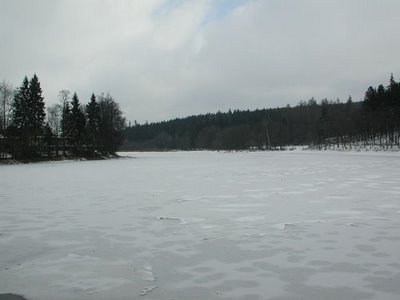 A frozen fish pond
A frozen fish pond
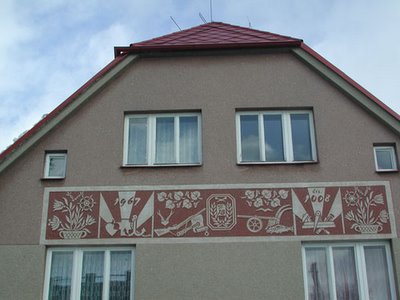 An ornamented house (there was a lot of domestic ornamentation, including a rope-climbing Santa)
An ornamented house (there was a lot of domestic ornamentation, including a rope-climbing Santa)
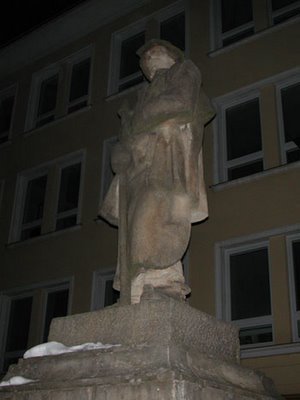 An industrial worker
An industrial worker
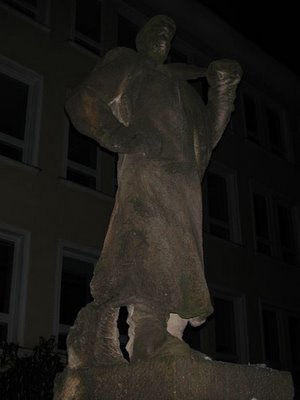 Another industrial worker
Another industrial worker
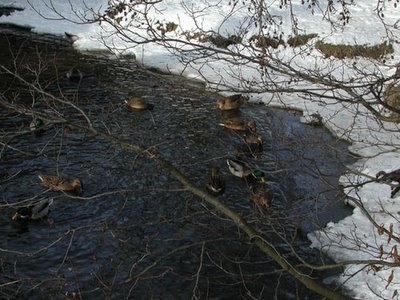 Some mallards
Some mallards
Our final adventure in the town came while we were sitting in the train station café having a substandard snack while awaiting our respective trains. I had bought a copy of Ateliér to look at on the train, but we were not looking at it; I have no idea what we were discussing, but at some point I became aware that the man at the next table was looking intently at us every now and then. I was unsure why that might be as we weren’t talking loudly or saying anything nearly as startling as some of the things we had said at other eateries (about prams and other topics).
Suddenly our neighbor arose from his seat and presented us with his copy of Lidové noviny. I was really quite unprepared to be given a newspaper, but as the article he was pointing to bore the title “Alfons Mucha ze zoo” and appeared to be an interview with the artist who designs the Prague zoo’s posters, I assumed that he thought anyone who read Ateliér must want to read about art in general. I think my mind was more on how long it would take for my coffee to cool to a drinkable state, and Jesse, who does speak much better Czech than I do, appeared to be in one of those states of mind designed to force me to practice my skills. Thus, I expressed our appreciation at being given the newspaper, our neighbor returned to his table, and we made a show of reading the article.
There was a lot to it, covering as it did the artist’s general background and opinions and his trip to Cuba. Unlike the online version of the article, the printed edition included an example of one of the zoo posters and a large photo of a couple standing in front of a mural that appeared to portray Fidel Castro. At least, I think it was Castro; the couple mostly obscured the mural. I tried to glean some clearer notion from the article why we ought to be so interested in it, but could only conclude that we looked art-historical.
After awhile I took the paper back to our neighbor and thanked him again for lending it to us. He seemed to want to engage me in conversation, so I said it was interesting and that I had seen some of the zoo posters in Prague but hadn’t known the artist was having an exhibition. (Nor, admittedly, had I actually cared one way or the other, but the posters are kind of nice.) My neighbor inquired where I was from. To make life simple, I said that I was from Pittsburgh, although sometimes it is a mistake to mention Pittsburgh to Czechs because they assume that I will know about the Czechs on its sports teams. All I know about sports in Pittsburgh is that the natives are devoted fans of whatever sports are played there.
Fortunately, my interlocutor did not quiz me on the sports of Pittsburgh. He said he had traveled in North America and spoke some English. Well, I suspected that his English would be worse than my Czech, so I did not really switch in to that language. He did seem surprised that the article, or the artist, was unfamiliar to me. I said I didn’t know anything about the artist except that I had seen his posters around Prague. Of course, it was interesting because I’m an art historian.
He examined me with great interest. What had brought us to Žďár and what did we think of it?
I replied that as I lived in Prague and my friend lived in Brno, we thought it would be a nice excursion to visit Žďár. I avoided mentioning skiing and stuck to the in-town attractions, although since most of them had been closed, I couldn’t be very specific. Fortunately, he agreed that it was a nice town. At this, I made my escape and found that Jesse had finished his sandwich and that my coffee had cooled to a drinkable temperature. We took a look at Ateliér and began to discuss the Cranach exhibition, although I couldn’t remember exactly what is Protestant about Cranach other than that he knew Luther. Jesse pointed out that the paintings in Ateliér looked Catholic to him, and it was hard to dispute this. I was better able to explain that the apple Eve fed Adam was once envisioned as being a citrus fruit.
Somewhat later, as we stood on the platform waiting for the Brno train, Jesse let on that it had been his impression that our neighbor imagined we were the couple in the photo.
“That’s what he said,” said Jesse.
“He did?” said I incredulously. This did not seem plausible to me. At all. “I thought he wanted us to see it because we had a copy of Ateliér.
“Well, that’s what I thought he said.”
I racked my brain to remember what on earth the people in the photo looked like. About all I could recall was that one was male and the other was female. “If that’s what he said, I completely missed that. What did they look like? I don’t remember them looking anything at all like us.”
“They didn’t look all that much like us. Maybe his eyes are bad. The woman had longish hair.”
This was disconcerting. My visual memory is extremely bad for an art historian, so it was not good that I could only recall the people in the photo as looking like tall obstacles to a not that interesting mural. Actually, I once took a test that indicated that my brain has an even split between both left brain-right brain and visual-auditory dominance, which is, you might say, both good and bad. (I’m sure it has mixed dominance in every other possible aspect as well.) Was it worse not to remember the photo or not to have gotten the opening remarks?
I pondered this and other, not entirely unrelated, matters on the train back to Prague. Life is always interesting for those of us with mixed dominance in our perceptual, conceptual, expressive, and other modes, but it is rarely as straightforward as our analytical left brains would like to pretend.
Generally, however, I think this is a good thing. At’ žije surrealismus!
We did find some additional items to photograph:
 A frozen fish pond
A frozen fish pond An ornamented house (there was a lot of domestic ornamentation, including a rope-climbing Santa)
An ornamented house (there was a lot of domestic ornamentation, including a rope-climbing Santa) An industrial worker
An industrial worker Another industrial worker
Another industrial worker Some mallards
Some mallardsOur final adventure in the town came while we were sitting in the train station café having a substandard snack while awaiting our respective trains. I had bought a copy of Ateliér to look at on the train, but we were not looking at it; I have no idea what we were discussing, but at some point I became aware that the man at the next table was looking intently at us every now and then. I was unsure why that might be as we weren’t talking loudly or saying anything nearly as startling as some of the things we had said at other eateries (about prams and other topics).
Suddenly our neighbor arose from his seat and presented us with his copy of Lidové noviny. I was really quite unprepared to be given a newspaper, but as the article he was pointing to bore the title “Alfons Mucha ze zoo” and appeared to be an interview with the artist who designs the Prague zoo’s posters, I assumed that he thought anyone who read Ateliér must want to read about art in general. I think my mind was more on how long it would take for my coffee to cool to a drinkable state, and Jesse, who does speak much better Czech than I do, appeared to be in one of those states of mind designed to force me to practice my skills. Thus, I expressed our appreciation at being given the newspaper, our neighbor returned to his table, and we made a show of reading the article.
There was a lot to it, covering as it did the artist’s general background and opinions and his trip to Cuba. Unlike the online version of the article, the printed edition included an example of one of the zoo posters and a large photo of a couple standing in front of a mural that appeared to portray Fidel Castro. At least, I think it was Castro; the couple mostly obscured the mural. I tried to glean some clearer notion from the article why we ought to be so interested in it, but could only conclude that we looked art-historical.
After awhile I took the paper back to our neighbor and thanked him again for lending it to us. He seemed to want to engage me in conversation, so I said it was interesting and that I had seen some of the zoo posters in Prague but hadn’t known the artist was having an exhibition. (Nor, admittedly, had I actually cared one way or the other, but the posters are kind of nice.) My neighbor inquired where I was from. To make life simple, I said that I was from Pittsburgh, although sometimes it is a mistake to mention Pittsburgh to Czechs because they assume that I will know about the Czechs on its sports teams. All I know about sports in Pittsburgh is that the natives are devoted fans of whatever sports are played there.
Fortunately, my interlocutor did not quiz me on the sports of Pittsburgh. He said he had traveled in North America and spoke some English. Well, I suspected that his English would be worse than my Czech, so I did not really switch in to that language. He did seem surprised that the article, or the artist, was unfamiliar to me. I said I didn’t know anything about the artist except that I had seen his posters around Prague. Of course, it was interesting because I’m an art historian.
He examined me with great interest. What had brought us to Žďár and what did we think of it?
I replied that as I lived in Prague and my friend lived in Brno, we thought it would be a nice excursion to visit Žďár. I avoided mentioning skiing and stuck to the in-town attractions, although since most of them had been closed, I couldn’t be very specific. Fortunately, he agreed that it was a nice town. At this, I made my escape and found that Jesse had finished his sandwich and that my coffee had cooled to a drinkable temperature. We took a look at Ateliér and began to discuss the Cranach exhibition, although I couldn’t remember exactly what is Protestant about Cranach other than that he knew Luther. Jesse pointed out that the paintings in Ateliér looked Catholic to him, and it was hard to dispute this. I was better able to explain that the apple Eve fed Adam was once envisioned as being a citrus fruit.
Somewhat later, as we stood on the platform waiting for the Brno train, Jesse let on that it had been his impression that our neighbor imagined we were the couple in the photo.
“That’s what he said,” said Jesse.
“He did?” said I incredulously. This did not seem plausible to me. At all. “I thought he wanted us to see it because we had a copy of Ateliér.
“Well, that’s what I thought he said.”
I racked my brain to remember what on earth the people in the photo looked like. About all I could recall was that one was male and the other was female. “If that’s what he said, I completely missed that. What did they look like? I don’t remember them looking anything at all like us.”
“They didn’t look all that much like us. Maybe his eyes are bad. The woman had longish hair.”
This was disconcerting. My visual memory is extremely bad for an art historian, so it was not good that I could only recall the people in the photo as looking like tall obstacles to a not that interesting mural. Actually, I once took a test that indicated that my brain has an even split between both left brain-right brain and visual-auditory dominance, which is, you might say, both good and bad. (I’m sure it has mixed dominance in every other possible aspect as well.) Was it worse not to remember the photo or not to have gotten the opening remarks?
I pondered this and other, not entirely unrelated, matters on the train back to Prague. Life is always interesting for those of us with mixed dominance in our perceptual, conceptual, expressive, and other modes, but it is rarely as straightforward as our analytical left brains would like to pretend.
Generally, however, I think this is a good thing. At’ žije surrealismus!

0 Comments:
Post a Comment
<< Home